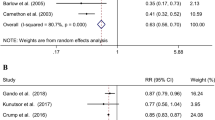Summary
Cardiovascular risk is substantially influenced by changes in habits. In this context the INTERHEART study showed that a healthy vitamin-packed nutrition and regular workout reduced the cardiovascular risk up to 79%. In this case people older than 50 years would benefit most from change. Patients suffering from obesity should combine a low-calory diet with physical training in order to reduce weight. Here optimal results can be achieved by considering intensity as well as quantity for each patient.
Zusammenfassung
Das kardiovaskuläre Risiko wird durch Änderungen von Lebensgewohnheiten substanziell beeinflusst. Eine Studie dazu, die INTERHEART-Studie von 2004, zeigt u. a., dass eine gesunde, vitaminreiche Ernährung sowie regelmäßiger Sport zu einer Senkung des Myokardinfarktrisikos um bis zu 79% beitragen, wovon bei einer Umstellung die über 50-Jährigen am meisten profitieren. Bei Patienten, die an Adipositas leiden, ist durch reduzierte Kalorienzufuhr in Verbindung mit körperlicher Betätigung eine kontrollierte Gewichtsreduktion durchzuführen. Hierbei ist nicht nur auf die Intensität, sondern auch auf das Maß bei jedem Patienten zu achten, um optimale Erfolge erzielen zu können.
Similar content being viewed by others
Literatur
Al-Delaimy WK, Manson JE, Solomon CG, Kawachi I, Stampfer MJ, Willett WC, Hu FB (2002) Smoking and risk of coronary heart disease among women with type 2 diabetes mellitus. Arch Intern Med 162:273
Anthonisen NR, Skeans MA, Wise RA, Manfreda J, Kanner RE, Connett JE for the Lung Health Study Research Group (2005) The effect of a smoking cessation intervention on 14.5-year mortality. Ann Intern Med 142:233
Goto C, Higashi Y, Kimura M, Noma K, Hara K, Nakagawa K, Kawamura M, Chayama K, Yoshizumi M, Nara I (2003) Effect of different intensities of exercise on endothelium-dependent vasodilation in humas: role of endothelium-dependent nitric oxide and oxidative stress. Circulation 108:530
Hambrecht R, Adams V, Erbs S, Linke A, Kränkel N, Shu Y, Baither Y, Gielen S, Thiele H, Gummert JF, Mohr FW, Schuler G (2003) Regular physical activity improves endothelial function in patients with coronary artery disease by increasing phosphorylation of endothelial nitiric oxide synthase. Circulation 107:3152
Lee I-M, Sesso HD, Oguma Y, Paffenbarger RS (2003) Relative intensity of physical activity and risk of coronary heart disease. Circulation 107:1110
Mora S, Yanek LR, Moy TF, Fallin MD, Becker LC, Becker DM (2005) Interaction of body mass index and Framingham risk score in predicting incident coronary disease in families. Circulation 111:1871
Pearl R (1938) Tobacco smoking and longevity. Science 87:216
Tanaka A, Shimada K, Sano T, Namba M, Sakamoto T, Nishida Y, Kawarabayashi T, Fukuda D, Yoshikawa J (2005) Multiple plaque rupture and C-reactive protein in acute myocardial infarction. J Am Coll Cardiol 45:1594
Dagenais GR, Yi Q, Lonn E, Slight P, Ostergren J, Yusuf S on behalf of the HOPE Trial Investigators (2005) Impact of cigarette smoking in high-risk patients participating in a clinical trail. A substudy from the Heart Outcomes prevention evaluation (HOPE) trial. Eur J Cardiovasc Prev and Reha 12:75
Yusuf S, Hawken S, Ounpuu S, Dans T, Avezum A, Lanas F, McQueen M, Budaj A, Pais P, Varigos J, Lisheng L, and INTERHEART Study Investigators (2004) Effect of potentially modifiable risk factors associated with myocardial infarction in 52 countries (the INTERHEART study): case-control study. Lancet 364:937
Author information
Authors and Affiliations
Rights and permissions
About this article
Cite this article
Völler, H. Stellenwert von Veränderungen der Lebensgewohnheiten zur Risikoreduktion. Clin Res Cardiol 95 (Suppl 6), vi6–vi11 (2006). https://doi.org/10.1007/s00392-006-1802-8
Issue Date:
DOI: https://doi.org/10.1007/s00392-006-1802-8




